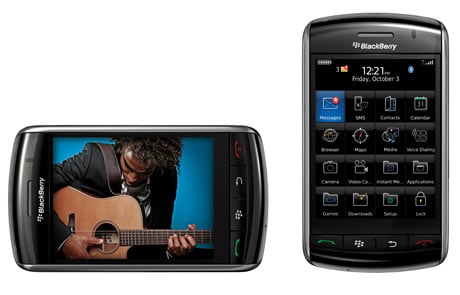Review: BlackBerry Storm2
-
 1/6
1/6Review: BlackBerry Storm2
The first touch-screen BlackBerry phone, the Storm, got a few things right, but generally it was a chore to use.
Good thing a lot can change in a year. Though not without flaws, the latest version of the device, the BlackBerry Storm2, is the phone Research In Motion Ltd. should have released last year: It's faster, smarter and more fun to use -
 2/6
2/6Review: BlackBerry Storm2
The Storm2's face is still dominated by a large, bright touch screen. The buttons that previously sat just below the screen have been integrated, making most of the phone's face one big, slick slab.
From the start, I found the Storm2 more responsive and accurate than its predecessor. When I reviewed the original Storm last November, I found the screen often took an irritating amount of time to change from portrait to landscape mode when I flipped the phone to one side or another. On the new Storm, there's little to no delay -
 3/6
3/6Review: BlackBerry Storm2
Owing to the latest BlackBerry software, the phone also makes it easier to scroll through lists of contacts and messages, though I still sometimes wished the scrolling was even quicker to bypass a block of text or bevy of e-mails.
The Storm's virtual keyboard has been improved as well: I could type on it more easily and made fewer mistakes when sending e-mails and text messages.
One of the most noticeable features of the original Storm was its combination of touch screen with physical feedback — you could mouse around the screen with your finger, but needed to press down on the screen to complete an action like opening an application. Trouble was, it required some force to push -
 4/6
4/6Review: BlackBerry Storm2
The new Storm keeps the click, but it's a little easier to push on the screen. It has also learned a neat new trick: When the phone is off or asleep, the screen doesn't click (and, because they're all connected, the buttons below it don't move either).
If you're an application junkie, RIM's BlackBerry App World may not satiate your appetite. It's still just a fraction the size of Apple's App Store, which has more than 100,000 applications. Fortunately, the basics are there for keeping up with Facebook friends, communicating through the short-messaging site Twitter, listening to music and checking the news -
 5/6
5/6Review: BlackBerry Storm2
I was surprised that RIM didn't upgrade the Storm's 3.2 megapixel camera to one-up rival Apple Inc. and its popular iPhone — especially as other phone makers including Motorola are incorporating cameras that leapfrog the 3 megapixels on the iPhone.
The Storm2 comes with a 16-gigabyte microSD card, doubling the amount of storage space for photos, videos and music.
And if you were bemoaning the lack of Wi-Fi on the first Storm, you'll be pleased to see it is included on the latest model -
 6/6
6/6Review: BlackBerry Storm2
Of course, aside from all the bells and whistles, a cell phone should be good for making calls. And while I had a strong reception nearly everywhere I took the Storm2, I didn't think calls sounded as clear as they could have. I also thought Web pages tended to load rather slowly, and photos on them appeared distorted several times.
The Storm2, which came out in late October, is available from Verizon Wireless for $179 with a two-year contract and after a rebate.
It isn't likely to be a game changer, but it is clear that RIM recognized and fixed the glaring problems found in the first version. If you were intrigued by the Storm last year but were nervous about making the commitment, chances are you'll be happier with it this time around.
(Rachel Metz, Associated Press)











